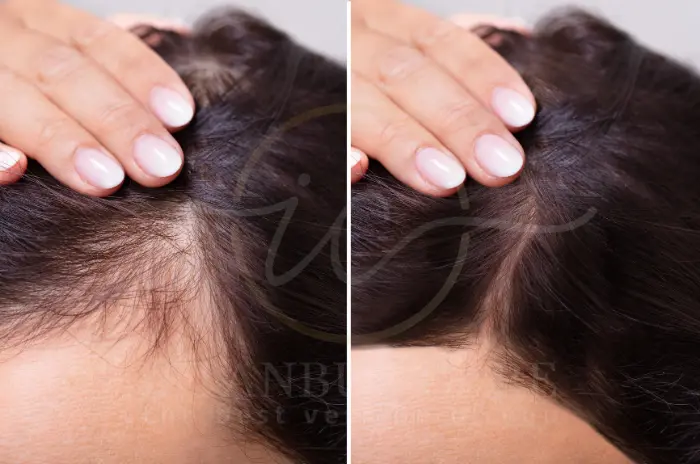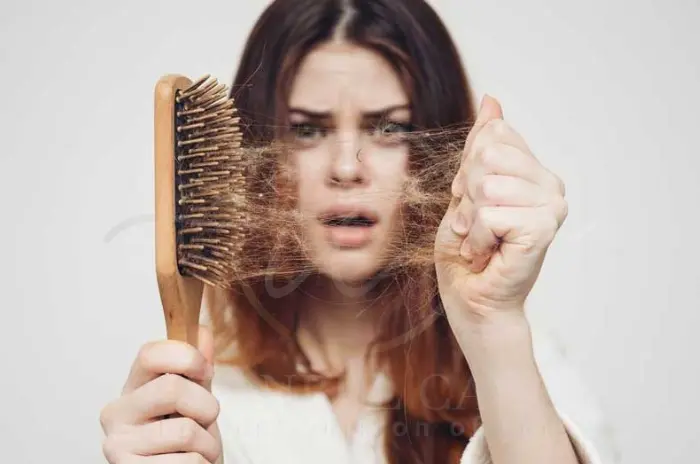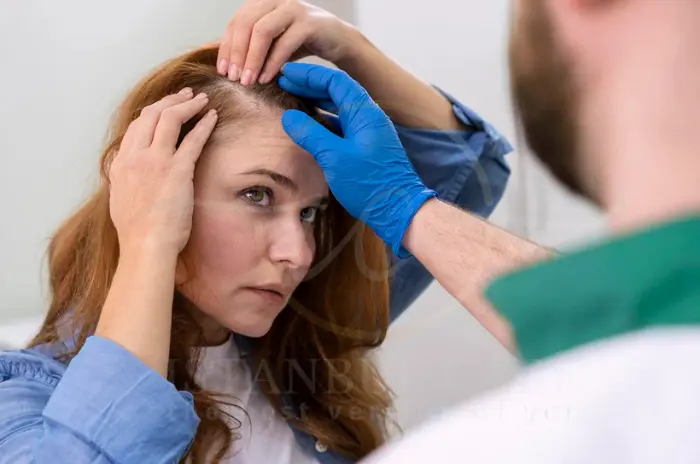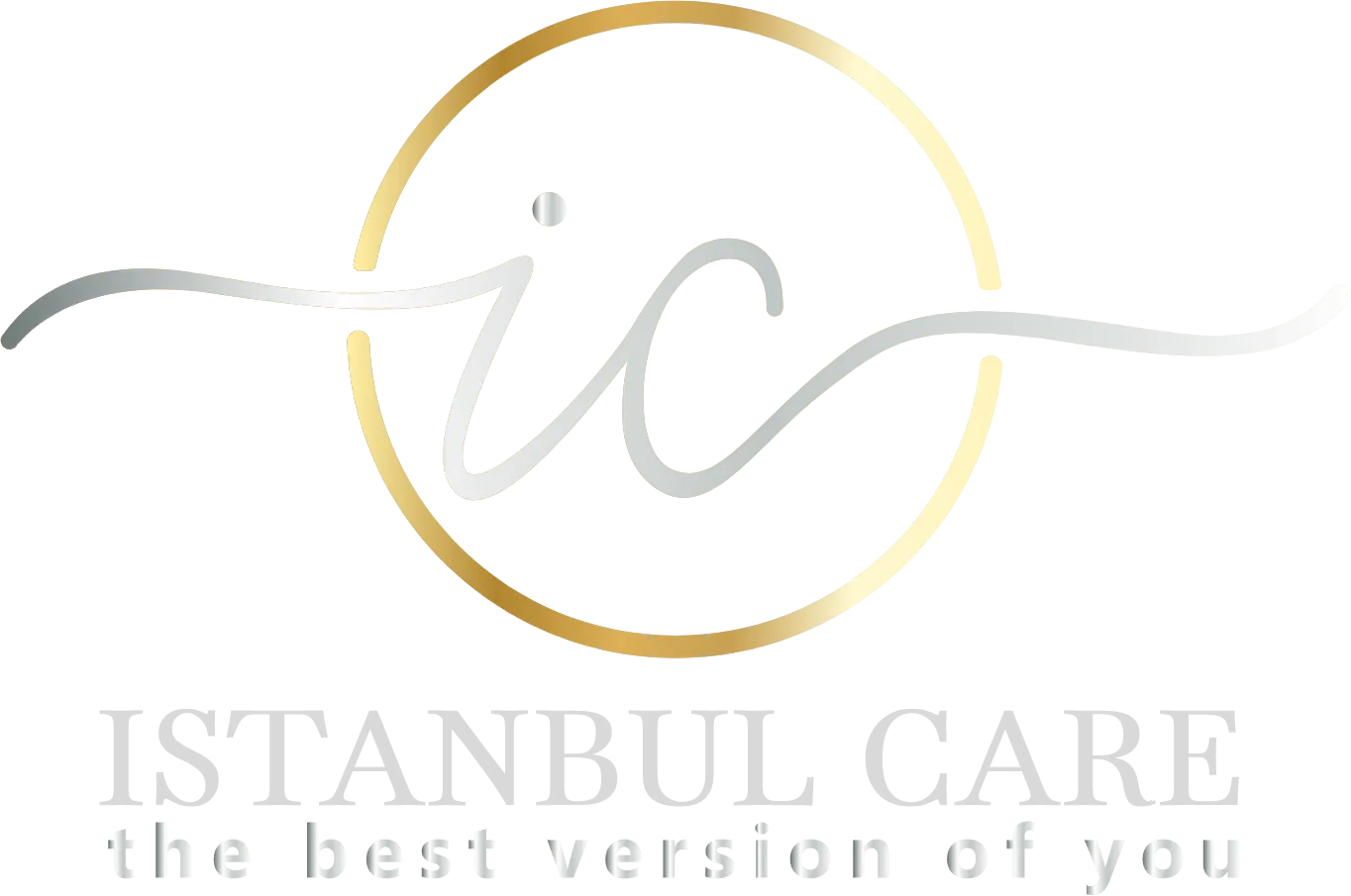Becoming a new mom brings incredible joy, but it can also come with unexpected changes to your body, including postpartum hair loss. Many women experience significant hair shedding postpartum, which can be alarming after the thick, lustrous hair many enjoyed during pregnancy. Understanding why hair loss after pregnancy occurs, when it typically happens, and how to manage it can help ease concerns and guide you toward effective solutions.
Postpartum hair loss is a temporary condition that affects up to 90% of women after pregnancy. While it can feel overwhelming to see clumps of hair in your brush or shower drain, this type of hair loss after childbirth is completely normal and part of your body’s natural recovery process. The good news is that with proper care and patience, your hair will typically return to its pre-pregnancy state.

What Is Postpartum Hair Loss?
Postpartum hair loss refers to the excessive hair shedding that many women experience in the months following childbirth. This condition, medically known as telogen effluvium postpartum, occurs when a large number of hair follicles enter the resting phase simultaneously, leading to noticeable hair thinning after birth.
During a normal hair growth cycle, only about 10-15% of your hair is in the resting phase at any given time. However, after pregnancy, this percentage can increase dramatically, causing more widespread hair loss. The condition typically begins 2-4 months after childbirth and can continue for several months as your body adjusts to post-pregnancy hormone levels.
Why Does Postpartum Hair Loss Happen?
Postpartum hair loss occurs due to dramatic hormonal changes that happen after pregnancy. Here are the key reasons:
- Estrogen levels drop significantly after delivery, ending the hair-preserving effects experienced during pregnancy
- Hormonal fluctuations disrupt the normal hair growth cycle, pushing many follicles into the shedding phase
- Sleep deprivation and stress from caring for a baby can exacerbate hair loss
- Nutritional demands from breastfeeding may affect hair health if dietary needs aren’t met
How Hormones Affect Hair After Pregnancy
The relationship between hormones and hair loss after birth is complex but well-understood. During pregnancy, elevated estrogen levels extend the growth phase of hair, resulting in thicker, fuller hair that many women enjoy. However, after delivery, estrogen levels plummet rapidly, causing the accumulated hair that should have been shed during pregnancy to fall out all at once.
This estrogen drop hair loss is the primary driver of postpartum shedding. Additionally, other hormonal changes, including fluctuations in progesterone and thyroid hormones, can contribute to the overall hair loss experience that new moms face.
How Long Does Postpartum Hair Loss Last?
Understanding the duration of postpartum hair loss can help set realistic expectations for recovery. Most women find that hair shedding postpartum follows a predictable timeline, though individual experiences may vary based on factors like genetics, overall health, and lifestyle.
The excessive hair loss after delivery typically peaks between 3-6 months postpartum and gradually improves over the following months. For most women, hair growth patterns return to normal by their child’s first birthday, though some may notice improvements as early as 6-9 months after pregnancy.
The Postpartum Hair Loss Timeline
The postpartum hair loss timeline generally follows this pattern:
- 2-4 months postpartum: Initial signs of increased hair shedding begin to appear
- 3-6 months postpartum: Peak period of hair loss, with the most noticeable thinning and shedding
- 6-12 months postpartum: Gradual improvement as new hair growth begins and shedding decreases
- 12-18 months postpartum: Hair density typically returns to pre-pregnancy levels for most women
When Will My Hair Grow Back?
Postpartum hair regrowth begins as soon as the shedding phase starts to subside, usually around 6-9 months after childbirth. New hair growth often appears as short, wispy “baby hairs” around the hairline and crown. These new hairs may have a different texture initially but typically normalize as they continue to grow.
The complete recovery process varies among individuals, but most women see significant improvement in hair density and overall appearance by 12-15 months postpartum. Patience is essential during this period, as hair grows approximately half an inch per month.
Is Postpartum Hair Loss Normal?
Postpartum hair loss is not only normal but expected for the vast majority of women after pregnancy. Research indicates that up to 90% of new moms experience some degree of hair shedding postpartum, making it one of the most common physical changes following childbirth.
This type of hair loss is considered a natural part of the postpartum recovery process, similar to other temporary changes like joint looseness or skin changes. Understanding that postnatal hair loss is temporary and reversible can help reduce anxiety and stress associated with this condition.
Signs That Hair Shedding Is Part of Recovery
Typical signs of normal postpartum hair loss include:
- Hair shedding that begins 2-4 months after childbirth rather than immediately
- Hair loss that affects the entire scalp rather than specific patches
- Gradual onset of thinning that becomes more noticeable over several weeks
- Hair loss accompanied by other postpartum changes like joint pain or mood fluctuations
When to Speak With a Doctor About Hair Loss
While postpartum hair loss is generally normal, certain situations warrant medical consultation:
- Hair loss that begins immediately after delivery or during pregnancy
- Patchy hair loss or bald spots rather than overall thinning
- Excessive hair loss that continues beyond 15 months postpartum
- Hair loss accompanied by other symptoms like extreme fatigue, weight changes, or mood disorders
Managing Postpartum Hair Loss
Effective management of postpartum hair loss involves gentle hair care practices, proper nutrition, and realistic expectations about the recovery timeline. While you cannot completely prevent hair shedding postpartum, you can minimize damage and support healthy regrowth through thoughtful approaches to hair care and overall wellness.
The key to managing hair loss after pregnancy lies in being gentle with your hair while it’s in this vulnerable state and providing your body with the nutrients it needs for optimal hair regrowth. Many women find that adjusting their hair care routine and lifestyle habits significantly improves their experience during this temporary phase.
Best Hair Care Tips for Postpartum Shedding
Gentle hair care is essential during the postpartum hair loss period:
- Use a wide-tooth comb to detangle wet hair, starting from the ends and working upward
- Choose a volumizing shampoo postpartum that adds body without weighing hair down
- Limit heat styling and chemical treatments that can further damage weakened hair
- Consider shorter hairstyles that create the illusion of fuller hair and are easier to manage with a baby
Hair Care Tips to Minimize Shedding
Specific techniques can help reduce hair shedding postpartum:
- Wash hair every 2-3 days rather than daily to reduce manipulation
- Use lukewarm water instead of hot water, which can dry out hair and scalp
- Apply conditioner only to the mid-lengths and ends of hair to avoid weighing down roots
- Sleep on silk or satin pillowcases to reduce friction and breakage during rest
| Hair Care During Pregnancy vs. Postpartum | During Pregnancy | After Pregnancy |
|---|---|---|
| Hair Thickness | Thicker, fuller hair due to estrogen | Gradual thinning and shedding |
| Washing Frequency | Can wash daily without excess shedding | Reduce to every 2-3 days to minimize manipulation |
| Heat Styling Safety | Generally safe with precautions | Limit use to prevent additional damage |
| Hair Growth Rate | Faster growth, longer growth phase | Slower growth as hormones readjust |
| Recommended Products | Regular shampoo and conditioner | Volumizing, sulfate-free formulas |
| Nutritional Needs | Prenatal vitamins essential | Continue prenatal vitamins plus targeted nutrients |
Nutrients That May Support Hair Regrowth
Proper nutrition plays a crucial role in supporting postpartum hair regrowth:
- Iron helps carry oxygen to hair follicles and is often depleted after pregnancy
- Biotin supports keratin production, which is essential for healthy hair structure
- Vitamin D plays a role in hair follicle health and cycling
- Protein provides the building blocks necessary for new hair growth

Causes of Postpartum Hair Loss
Understanding the underlying causes of postpartum hair loss helps normalize the experience and guides appropriate treatment approaches. The primary drivers of hair loss after childbirth are rooted in the dramatic physiological changes that occur as your body transitions from pregnancy to postpartum recovery.
Multiple factors contribute to postpartum shedding, with hormonal changes being the most significant. However, other elements like stress, nutritional demands, and sleep deprivation can exacerbate the condition and influence its severity and duration.
Hormonal Changes and Hair Shedding
The most significant cause of postpartum hair loss is the dramatic shift in hormone levels that occurs after delivery:
- Estrogen levels drop by up to 100-fold within the first week after delivery
- Progesterone levels also decrease rapidly, contributing to hair cycle disruption
- Prolactin levels remain elevated if breastfeeding, which can affect hair growth
- Thyroid hormone fluctuations may occur postpartum, potentially affecting hair health
The Role of Telogen Effluvium in Postpartum Hair Loss
Telogen effluvium postpartum is the medical term for the specific type of hair loss that occurs after pregnancy. This condition involves a large number of hair follicles entering the telogen (resting) phase simultaneously, leading to diffuse hair shedding approximately 2-4 months later.
During telogen effluvium, up to 30% of hair follicles may be in the resting phase, compared to the normal 10-15%. This synchronization of hair cycles results in the noticeable hair thinning after birth that many new moms experience.
Symptoms of Postpartum Hair Loss
Recognizing the symptoms of postpartum hair loss can help distinguish it from other types of hair loss and provide reassurance that what you’re experiencing is normal. The symptoms typically develop gradually and affect the overall hair density rather than creating distinct bald patches.
Hair loss after pregnancy has characteristic patterns and timing that differentiate it from other conditions like alopecia areata or androgenetic alopecia. Understanding these distinctions can help you determine whether your hair shedding is part of normal postpartum recovery.
How Much Hair Loss Is Normal After Pregnancy?
Normal postpartum hair loss involves shedding 50-100 hairs per day initially, increasing to 300-500 hairs per day during peak shedding periods. This may seem alarming, but it represents the delayed shedding of hair that was retained during pregnancy due to elevated estrogen levels.
The hair loss typically affects the entire scalp uniformly, with many women noticing particular thinning around the hairline and temples. This pattern is characteristic of hormonal hair loss and helps differentiate it from other conditions that might cause more localized hair loss.
Signs Your Hair Loss Is Postpartum-Related
Key indicators that your hair loss is postpartum-related include:
- Onset occurring 2-6 months after childbirth rather than during pregnancy
- Diffuse thinning across the entire scalp rather than patchy hair loss
- Hair shedding that increases gradually over several weeks or months
- Accompanying symptoms like mood changes, joint pain, or other postpartum recovery signs
How to Treat Postpartum Hair Loss
While postpartum hair loss cannot be completely prevented, various treatments and approaches can support hair health and minimize the impact of hair shedding postpartum. The most effective treatments focus on supporting overall health, providing essential nutrients, and using gentle hair care practices during this temporary phase.
Treatment approaches should be realistic and focus on supporting natural recovery rather than expecting immediate results. Most new moms find that a combination of lifestyle adjustments, proper nutrition, and gentle hair care provides the best outcomes for managing hair loss after pregnancy.
Natural Ways to Care for Your Hair
Natural approaches to managing postpartum hair loss include:
- Scalp massage to stimulate blood circulation and promote hair follicle health
- Essential oils like rosemary or peppermint, which may support hair growth when diluted properly
- Stress management techniques such as meditation or yoga to reduce cortisol levels
- Adequate sleep when possible, as rest is crucial for hair follicle recovery
Hair Products That Can Help
Certain products can support hair health during postpartum shedding:
- Volumizing shampoos that add body without stripping natural oils
- Sulfate-free formulas that are gentler on weakened hair
- Leave-in treatments with biotin or keratin to strengthen existing hair
- Dry shampoos to extend time between washes and reduce manipulation
Vitamins and Nutrition for Postpartum Hair Health
Best vitamins for postpartum hair loss include those that support overall hair health:
- Prenatal vitamins continued postpartum provide comprehensive nutrition support
- Iron supplements if deficiency is confirmed through blood testing
- Biotin supplements may support hair strength and growth
- Vitamin D supplementation if levels are found to be insufficient
When to See a Doctor About Hair Loss
Medical consultation is recommended when:
- Hair loss persists beyond 15 months postpartum without improvement
- Excessive hair loss is accompanied by other concerning symptoms
- Patchy hair loss or complete bald spots develop
- Thyroid symptoms like extreme fatigue or weight changes accompany hair loss
Postpartum Hair Regrowth and Recovery
Postpartum hair regrowth is a gradual process that requires patience and realistic expectations. The recovery timeline varies among individuals, but most women begin to notice improvements in hair density and overall appearance between 6-12 months after childbirth.
Understanding what to expect during the regrowth phase can help manage expectations and reduce anxiety about the recovery process. Hair regrowth often occurs in stages, with initial improvements in hair shedding followed by visible new growth and eventual restoration of hair density.
What to Expect as Your Hair Grows Back
The postpartum hair regrowth process typically follows these stages:
- Reduced shedding becomes noticeable first, usually around 6-9 months postpartum
- New hair growth appears as short, fine hairs around the hairline and temples
- Hair density gradually improves as new growth lengthens and matures
- Hair texture may temporarily differ from pre-pregnancy hair but typically normalizes
Dealing with Baby Hairs and New Growth
The appearance of “baby hairs” is actually a positive sign of hair regrowth, though they can be challenging to style:
- Use lightweight styling products to help control flyaway new growth
- Consider gentle hair accessories like soft headbands to manage shorter pieces
- Be patient with styling, as new hairs need time to reach a manageable length
- Avoid harsh styling techniques that could damage delicate new growth

When to Seek Help for Postpartum Hair Loss
While postpartum hair loss is typically a normal, temporary condition, certain situations warrant professional medical evaluation. Knowing when to seek help can ensure that any underlying conditions are identified and treated appropriately, while also providing peace of mind during the recovery process.
Most hair loss after pregnancy resolves naturally without medical intervention. However, persistent or severe hair shedding may indicate other health issues that require attention, such as thyroid disorders, nutritional deficiencies, or autoimmune conditions.
Signs Your Hair Loss May Need Medical Attention
Seek medical evaluation if you experience:
- Hair loss that continues or worsens after 15 months postpartum
- Sudden onset of severe hair shedding immediately after delivery
- Patchy hair loss or distinct bald spots rather than diffuse thinning
- Hair loss accompanied by symptoms like rapid weight loss, palpitations, or severe fatigue
Other Causes of Hair Loss After Pregnancy
While hormonal changes are the primary cause of postpartum hair loss, other factors can contribute:
- Thyroid disorders, which are more common in the postpartum period
- Iron deficiency anemia from blood loss during delivery or inadequate nutrition
- Autoimmune conditions that may be triggered by pregnancy and childbirth
- Medications used during pregnancy or breastfeeding that may affect hair growth
The Postpartum Hair Loss Timeline
Understanding the detailed timeline of postpartum hair loss helps set appropriate expectations and reduces anxiety about the process. The timeline can vary based on individual factors, but most women experience a predictable pattern of hair shedding and recovery after pregnancy.
Factors that may influence your personal timeline include genetics, overall health status, breastfeeding duration, stress levels, and nutritional status. While individual experiences vary, the general pattern remains consistent across most new moms.
When Does Postpartum Hair Loss Start and Stop?
The typical postpartum hair loss timeline includes:
- 2-4 months postpartum: Initial increase in hair shedding begins
- 3-6 months postpartum: Peak period of hair loss, with maximum shedding
- 6-9 months postpartum: Gradual reduction in hair shedding begins
- 9-15 months postpartum: Hair density improvement becomes noticeable
What to Expect During the Regrowth Phase
The regrowth phase of postpartum hair recovery involves several distinct changes:
- Decreased shedding is often the first sign of improvement
- New growth appears as fine, short hairs around the hairline
- Hair texture changes may occur temporarily as hormones continue to stabilize
- Gradual thickening occurs as new hairs mature and existing hairs strengthen
Preventing Postpartum Hair Loss
While postpartum hair loss cannot be completely prevented due to its hormonal basis, certain strategies may help minimize its severity and support faster recovery. These tips to manage postpartum hair loss focus on overall health optimization and gentle hair care practices.
Preventing postpartum hair loss is more about supporting your body’s natural recovery process than stopping the condition entirely. The goal is to create optimal conditions for hair health while your hormones stabilize after pregnancy.
Tips to Minimize Hair Shedding After Birth
Strategies to reduce the impact of postpartum shedding include:
- Continue prenatal vitamins throughout breastfeeding to maintain nutritional support
- Gentle hair handling to avoid unnecessary breakage during the vulnerable period
- Stress management through relaxation techniques, support systems, and adequate rest
- Regular meals to maintain stable blood sugar and provide consistent nutrient availability
Healthy Habits for Stronger Postpartum Hair
Building healthy habits supports overall hair health during recovery:
- Balanced nutrition with adequate protein, healthy fats, and micronutrients
- Regular exercise when cleared by your healthcare provider to improve circulation
- Adequate hydration to support overall cellular function and hair health
- Quality sleep when possible, as rest is essential for tissue repair and hormone regulation
Managing Stress and Nutrition
Stress management and proper nutrition are crucial for minimizing postpartum hair loss:
- Practice stress-reduction techniques like deep breathing, meditation, or gentle yoga
- Prioritize nutrient-dense foods including leafy greens, lean proteins, and healthy fats
- Consider professional support for postpartum mood changes that may affect stress levels
- Stay consistent with healthy habits rather than pursuing drastic changes
The Science Behind Postpartum Hair Loss
Understanding the scientific mechanisms behind postpartum hair loss provides insight into why this condition is so common and why it typically resolves naturally over time. The causes of postpartum hair loss are rooted in well-understood physiological processes that occur as the body transitions from pregnancy to postpartum recovery.
The hair growth cycle consists of three phases: anagen (growth), catagen (transition), and telogen (resting). During pregnancy, elevated estrogen levels prolong the anagen phase, resulting in thicker hair. After pregnancy, the dramatic drop in estrogen causes many follicles to enter telogen simultaneously.
How Hormones Affect Your Hair Growth Cycle
Hormones and hair loss after birth are intricately connected through several mechanisms:
- Estrogen normally prolongs the growth phase of hair, keeping more follicles active
- When estrogen drops after delivery, follicles shift to the resting phase en masse
- Progesterone changes also contribute to alterations in the hair growth cycle
- Other hormones like thyroid hormones and cortisol can influence hair health postpartum
Telogen Effluvium: The Medical Term for Postpartum Shedding
Telogen effluvium postpartum is characterized by:
- Diffuse hair thinning rather than patchy hair loss
- Delayed onset occurring 2-4 months after the triggering event (childbirth)
- Temporary nature with spontaneous recovery as hormone levels stabilize
- Reversible process that doesn’t damage hair follicles permanently
Diet and Lifestyle for Postpartum Hair Regrowth
Nutrition and lifestyle factors play crucial roles in supporting postpartum hair regrowth and overall recovery. While dietary changes cannot immediately stop hair shedding postpartum, they can provide the building blocks necessary for healthy new hair growth and may help minimize the duration and severity of hair loss.
The demands of pregnancy, childbirth, and breastfeeding can deplete certain nutrients that are essential for hair health. Focusing on replenishing these nutrients while maintaining overall wellness supports the body’s natural recovery process.
Foods That Support Healthy Hair
Nutrient-rich foods that support hair regrowth include:
- Protein sources like lean meats, fish, eggs, and legumes provide amino acids for hair structure
- Iron-rich foods such as spinach, lean red meat, and lentils support oxygen transport to follicles
- Omega-3 fatty acids from fish, walnuts, and flaxseeds promote scalp health
- Biotin-rich foods including eggs, nuts, and sweet potatoes support hair strength
Supplements and When to Talk to a Doctor
Consider discussing supplements with your healthcare provider:
- Prenatal vitamins continued postpartum provide comprehensive nutritional support
- Iron supplements may be necessary if blood tests reveal deficiency
- Vitamin D supplementation should be based on blood level testing
- Specialized hair supplements should be evaluated for safety during breastfeeding
Is Your Hair Loss Normal or Excessive?
Distinguishing between normal postpartum hair loss and excessive hair shedding that may require medical attention is important for ensuring appropriate care. While most hair loss after pregnancy falls within the normal range, understanding when hair shedding becomes concerning helps guide decisions about seeking professional evaluation.
Normal postpartum hair loss has characteristic patterns, timing, and severity that differentiate it from other conditions. Recognizing these patterns can provide reassurance and help identify situations that warrant medical consultation.
What Counts as Excessive Hair Shedding
Excessive hair loss after delivery may be indicated by:
- Hair loss that begins immediately after delivery rather than 2-4 months later
- Shedding that continues to worsen after 6 months postpartum
- Patchy hair loss or distinct bald spots rather than diffuse thinning
- Hair loss that significantly impacts daily life or causes severe emotional distress
| Normal Postpartum Hair Loss | Concerning Hair Loss |
|---|---|
| Begins 2-4 months after delivery | Starts immediately after delivery |
| Diffuse thinning across scalp | Patchy or localized hair loss |
| Peaks at 3-6 months postpartum | Continues worsening after 6 months |
| Gradual improvement by 12 months | No improvement by 15 months |
| 300-500 hairs shed daily at peak | Sudden dramatic increase in shedding |
Speak with our expert Hair Transplantation specialists

Speak with our expert Hair Transplantation specialists
We’re ready to answer your questions
FAQs for Postpartum Hair Loss Causes, Timeline and Treatment Options
Postpartum hair loss is temporary hair shedding that occurs 2-6 months after childbirth due to hormonal changes, particularly the dramatic drop in estrogen levels that ends the hair-preserving effects of pregnancy.
Postpartum hair loss typically lasts 6-12 months, with peak shedding occurring 3-6 months after delivery and gradual improvement beginning around 6-9 months postpartum.
Postpartum hair loss is completely normal and affects up to 90% of women after pregnancy; concern is only warranted if hair loss is patchy, starts immediately after delivery, or persists beyond 15 months.
Managing postpartum hair loss involves gentle hair care with wide-tooth combs, volumizing shampoos, minimal heat styling, adequate nutrition, stress management, and patience during the natural recovery process.
Best vitamins for postpartum hair loss include continued prenatal vitamins, iron (if deficient), biotin, and vitamin D, though consultation with healthcare providers is recommended before starting new supplements.
Breastfeeding doesn’t directly cause postpartum hair loss, but the hormonal changes associated with lactation can prolong the hair shedding period by maintaining certain hormone levels that affect hair cycles.
See a doctor if hair loss persists beyond 15 months, begins immediately after delivery, involves patchy hair loss, or is accompanied by symptoms like extreme fatigue or weight changes.
During postpartum hair regrowth, expect reduced shedding first, followed by new “baby” hairs around the hairline, gradual density improvement, and potential temporary texture changes before full recovery.

